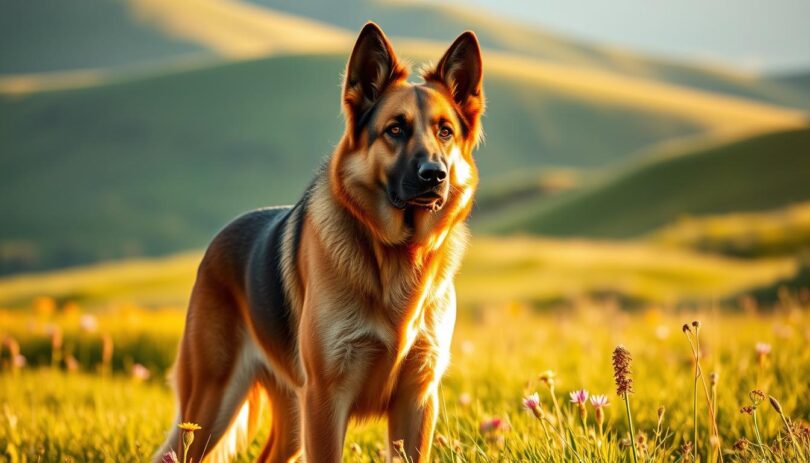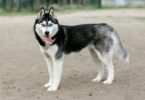Did you know 63% of working canines in U.S. law enforcement trace their lineage to a single ancestor from 1899? This iconic bloodline began with Horand von Grafrath, the first registered example of the breed known for its wolf-like appearance and unmatched versatility.
The distinctive “sable” pattern creates a mesmerizing ombré effect, with fur transitioning from light roots to darker tips. Developed for herding and protection, these animals combine sharp intelligence with steadfast loyalty. Their legacy as working partners continues today through roles in search missions and service tasks.
Owners often describe them as vigilant companions who thrive on mental challenges. Regular exercise and structured training help channel their energy positively. Potential health considerations like hip health require attention, but proper care supports a 10-14 year lifespan.
From their historical roots to modern family life, this guide explores key traits every enthusiast should know. You’ll discover how their unique coat develops, effective training methods, and strategies to maintain physical wellness. Whether you’re considering adoption or simply curious, understanding these elements helps appreciate what makes this variation truly special.
Overview of the Sable German Shepherd Dog
One glance at their striking fur reveals why this breed stands out. The signature coat color features a gradient effect, with lighter shades at the base blending into rich, darker hues at the tips. This natural ombré isn’t just eye-catching—it reflects a genetic trait preserved through generations of careful breeding.
What Defines a Sable German Shepherd
Beyond their appearance, these canines are celebrated for sharp problem-solving skills. Their ability to learn complex commands quickly makes them ideal for roles requiring focus, from search operations to agility competitions. Mental stimulation is crucial to prevent boredom, as their active minds thrive on challenges.
Key Attributes and Legacy
Loyalty and adaptability define their temperament. While naturally protective, they form deep bonds with families when socialized early. Breeders prioritized traits like endurance and versatility, resulting in animals equally capable of herding livestock or comforting children.
Modern enthusiasts value this legacy, maintaining standards through ethical practices. Consistent training and physical activity help channel their energy productively. With proper care, they excel as both working partners and devoted companions.
History and Origins of the Breed
Modern canine history changed forever in 1899 when cavalry captain Max von Stephanitz encountered a wolf-like herding animal at a Karlsruhe exhibition. This meeting sparked a breeding revolution focused on creating versatile working companions with distinct physical traits.
The Role of Max von Stephanitz
Von Stephanitz registered Horand von Grafrath as the foundation sire of the breed in 1899. He championed the unique agouti coat pattern – now called “sable” – recognizing its connection to ancestral working ability. Early breeders prioritized this coloration as proof of genetic purity, using it to distinguish capable herders from show-line counterparts.
Evolution from Early Sable Variants
Original sable-coated specimens displayed darker tips over lighter undercoats, a natural camouflage for field work. By 1906, von Stephanitz's breeding program refined these traits while maintaining sharp intelligence. The term “sable” became official in pedigrees to describe tan bases with black overlays.
Post-WWII breeding emphasized both form and function. Modern working lines retain the rugged build and problem-solving skills of their ancestors. Ethical breeders still reference historical standards when pairing mates, ensuring today's dogs honor their heritage through both appearance and aptitude.
Understanding Unique Coat Colors and Physical Traits
Ever wondered why some canines have fur that appears to shift shades like sunlight through trees? Their layered coat serves both functional and aesthetic purposes, adapting across seasons while maintaining breed-defining traits.
Distinctive Sable Coat Characteristics
Each strand displays a gradient effect, starting light at the base and darkening toward the tip. This creates natural camouflage, blending into shadows during fieldwork. Variations like red, silver, or tan overlays occur due to inherited pigment patterns.
Coat Progression and Variations
Puppies often show patchy darker markings that stabilize into uniform bands by age three. Short-haired types have dense, weather-resistant fur, while long-haired versions require weekly brushing to prevent tangles. Unlike solid-colored counterparts, this pattern highlights muscle definition during movement.
Ethical breeding programs prioritize preserving these traits without compromising health. Regular grooming maintains the coat’s protective qualities while showcasing its dynamic hues. Whether working or relaxing at home, their physical adaptability remains a testament to purposeful design.
Temperament and Personality Insights
A well-socialized sable German shepherd thrives in active households, blending vigilance with affection. Studies show early exposure to diverse environments shapes their confidence, making them adaptable to both service roles and family life. Their temperament reflects centuries of selective breeding for loyalty and problem-solving—traits that demand thoughtful engagement.
Loyalty, Independence, and Intelligence
This breed forms unshakable bonds with its family while retaining a self-reliant streak. Their sharp minds excel at learning commands quickly but may test boundaries without consistent guidance. Puzzle toys and obedience drills channel their energy constructively, preventing boredom-driven behaviors like chewing or digging.
Social Behavior and Family Compatibility
Proper socialization before 16 weeks ensures they interact calmly with children and other pets. Positive reinforcement works best—reward-based training builds trust and reinforces desired actions. Active households that provide daily walks, play sessions, and structured routines see the most harmonious relationships.
Balanced nutrition supports both physical health and mental focus. Combine high-quality protein with interactive games to satisfy their working heritage. Remember: a stimulated sable German shepherd is a content companion, ready to protect and participate in family adventures.
Health Considerations and Common Issues
Many owners are surprised to learn that joint issues affect over 20% of large breeds by age five. For active working dogs, proactive care is essential to address hereditary risks while supporting their energetic lifestyles. Early intervention and tailored routines can significantly improve long-term outcomes.
Joint Concerns: Hip and Elbow Dysplasia
Genetic factors from early breeding practices make hip and elbow dysplasia common in this breed. These conditions occur when joints develop improperly, causing pain during movement. Low-impact exercises like swimming and controlled play sessions help maintain muscle strength without straining vulnerable areas.
Annual vet screenings detect subtle changes before symptoms worsen. Pairing joint supplements with orthopedic bedding reduces pressure on limbs during rest. Structured training schedules also prevent overexertion, balancing activity with recovery time.
Degenerative and Spinal Conditions
Degenerative myelopathy, a spinal cord disorder, often appears in older dogs. Watch for dragging paws or difficulty standing—early signs require immediate attention. Diets rich in omega-3 fatty acids support nerve health, while regular light exercise preserves mobility.
Owners should avoid high-impact activities like repetitive jumping. Instead, focus on mental stimulation through scent games or obedience drills. Combining preventive measures with routine checkups helps these loyal companions stay active well into their senior years.
Exercise and Training Requirements
Maintaining peak performance in working-line canines demands a strategic approach to physical and mental engagement. These intelligent animals excel when their routines combine structured activity with problem-solving tasks. A balanced regimen prevents restlessness while reinforcing their natural drive to work.
Daily Physical Activity and Mental Stimulation
At least one to two hours of varied exercise daily keeps energy levels manageable. Activities like hiking or agility courses build endurance, while fetch sessions sharpen reflexes. Interactive games with other pets promote social skills and burn excess stamina.
Mental challenges are equally vital. Puzzle toys that dispense treats encourage logical thinking. Rotate tasks weekly—obedience drills one day, scent detection games the next. This variety taps into their problem-solving instincts, preventing boredom.
Positive Reinforcement and Advanced Training Tips
Reward-based methods strengthen trust and accelerate learning. Use treats or praise immediately after desired behaviors, like recalling on command. Short, frequent sessions—10 minutes, three times daily—yield better retention than marathon drills.
Advanced skills like guard work require professional guidance. Focus on consistency: same cues, same rewards. Schedule specific “training hours” to establish routines. Pair physical exercises with cognitive tasks, such as navigating obstacle courses, for holistic development.
Remember: a stimulated mind complements a tired body. Tailor activities to their heritage—tasks that mimic herding or protection roles often resonate deeply. With patience and creativity, owners unlock their companion’s full potential.
Nutrition and Grooming Essentials
Proper care extends beyond training—it starts with fueling their bodies and maintaining their signature coat. A tailored approach to diet and grooming preserves both vitality and that iconic ombré fur pattern.
Balanced Diet for Optimal Health
High-quality protein forms the foundation of their meals. Look for kibble with 22-26% animal-based protein to support lean muscle mass. Puppies benefit from calcium-rich formulas to aid bone development, while adults thrive on joint-supporting nutrients like glucosamine.
Incorporate omega fatty acids through fish oil supplements or occasional salmon. These nutrients enhance coat shine and skin health. Always consult your vet when switching foods—sudden changes can upset sensitive stomachs.
Grooming Needs Across Coat Types
Short-haired varieties need weekly brushing with a rubber curry comb. This removes loose fur and distributes natural oils. During spring shedding, increase sessions to three times weekly using an undercoat rake.
Longer coats demand daily attention. Use a slicker brush to prevent tangles behind ears and along the tail. Professional trims every 8-12 weeks maintain shape while preserving color depth. Always check for skin irritations during grooming—early detection prevents complications.
Pair these routines with annual vet exams. Bloodwork can reveal nutritional gaps affecting coat quality. Remember: what goes into their bowl directly impacts what you see on their brush.
The Sable German Shepherd as a Versatile Working Dog
Few breeds transition as seamlessly between duty and home life as these agile protectors. Their genetic blueprint combines situational awareness with an uncanny ability to adapt, making them equally effective in high-stakes jobs and family settings. This duality stems from generations of selective breeding for both physical stamina and emotional intelligence.
Roles in Protection, Service, and Family Environments
Law enforcement agencies frequently deploy these canines for narcotics detection and suspect apprehension. One K9 unit in Colorado credits their sable-coated partner with locating 12 missing persons in three years. Military handlers value their focus during explosive ordnance disposal missions, where precision saves lives.
Service roles harness their problem-solving instincts. Therapy dogs in schools help children manage anxiety through structured interactions. At home, they intuitively adjust energy levels—vigilant during neighborhood walks yet gentle with toddlers.
Urban dwellers appreciate their space adaptability. Apartments become patrol zones when paired with daily park visits. Rural owners utilize their herding heritage to manage livestock. Consistent training transforms natural caution into disciplined protection behaviors.
The iconic coat pattern serves as a living tribute to their working roots. Each shaded strand echoes ancestral dogs that guarded flocks under open skies. Modern breeding preserves this legacy while refining traits for contemporary challenges.
Determining if a Sable German Shepherd is Right for You
Is your daily routine built around movement and purpose? These high-drive companions thrive in environments where physical activity and mental challenges are non-negotiable. Their working heritage demands more than casual walks—think structured training sessions, puzzle-based games, and opportunities to apply problem-solving skills.
Matching Lifestyle with High-Energy Needs
Prospective owners should evaluate three key factors: available time, living space, and experience level. Urban dwellers can succeed with dedicated exercise plans, but access to parks or trails proves essential. Those in apartments must commit to multiple daily outings to prevent restlessness.
Training consistency separates successful partnerships from mismatched pairings. These intelligent animals require clear boundaries and ongoing skill development. Without proper engagement, their natural curiosity may lead to destructive behaviors like chewing or digging.
Consider your long-term schedule before adoption. A 12-year commitment means prioritizing morning runs despite weather, evening training regardless of fatigue, and budget for professional guidance. Families with young children should assess their ability to supervise interactions, as herding instincts might surface during play.
For those experienced with working dog breeds, the rewards outweigh the demands. Observe energy levels during meet-and-greets with breeders or rescue organizations. Many facilities offer trial periods to test compatibility before finalizing adoption.
Honest self-assessment ensures mutual fulfillment. When lifestyles align, these loyal partners become irreplaceable members of active households.
Final Reflections on Embracing the Sable German Shepherd Experience
Owning a sable German shepherd means partnering with a living legacy. Their striking ombré coat reflects generations of purposeful breeding, while their sharp instincts echo working dogs that shaped modern canine history. This blend of beauty and capability demands thoughtful stewardship.
Success hinges on honoring their needs. Structured training, joint-friendly exercise, and premium nutrition form the foundation of a thriving life together. Early socialization and mental challenges prevent boredom, transforming raw energy into focused companionship.
Prospective owners should weigh their capacity for this commitment. Reputable breeders and rescue organizations offer valuable insights into matching lifestyles with a shepherd’s drive. Regular vet checks and preventive care help sustain their vigor through every life stage.
Those ready to embrace the journey will find unparalleled loyalty in return. With patience and knowledge, these intelligent partners flourish—whether patrolling a backyard or curled at your feet. Let this guide inspire informed decisions, ensuring both human and canine thrive in harmony.
FAQ
How does the coat color change as these dogs age?
Puppies often display darker roots that lighten over time, with adult coats developing multi-toned bands. The final coloration stabilizes around 2-3 years, though some may keep subtle shading shifts.
Are there specific health screenings recommended for this breed?
Yes, reputable breeders prioritize OFA (Orthopedic Foundation for Animals) certifications for hip/elbow joints and genetic tests for degenerative myelopathy. Annual vet checks help monitor spinal health and mobility.
How challenging is training for first-time owners?
Their high intelligence requires consistent, engaging methods like clicker training or puzzle toys. Early socialization and obedience classes are crucial to channel their energy productively.










Leave a Comment